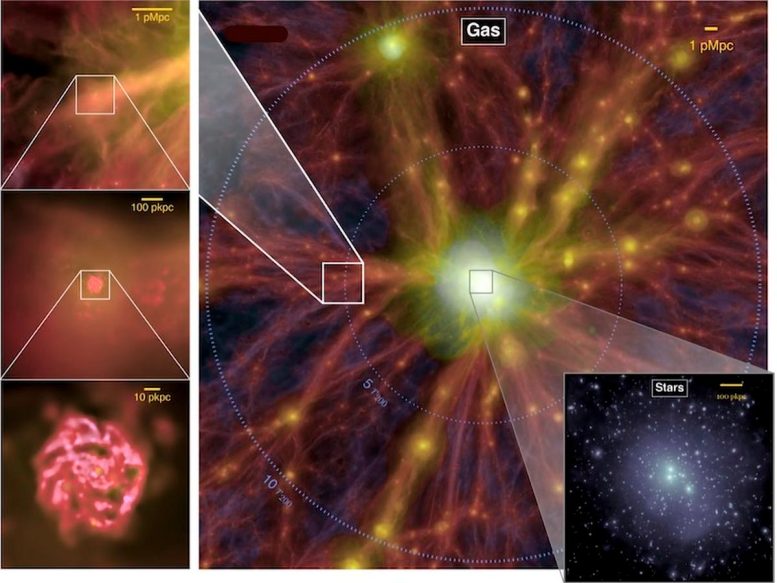The Impact of Invisible Threads from the Cosmic Web on Galaxy Formation

A visualization of a computer model showing the configuration of gas and stars in a galaxy cluster is presented, which emphasizes the way in which galaxy clusters are situated within the cosmic web of filaments. In the imagery, the image's intensity and color mirror the gas's density and temperature. These images illustrate a series of zoomed-in views of a galaxy situated in a filament. Beginning in the top right and progressing counterclockwise, the scale bars denote distances of 3.3 million light years (twice), 330 thousand light years, and 33 thousand light years. The lower right image shows the stars present in the galaxies of this theoretical cluster, with the scale bar equivalent to 330 thousand light years. The WISESize program will utilize observations to calculate the spatial distribution of gas and stars in galaxies as they traverse the pervasive cosmic web in the nearby universe. Credit: Yannick Bahé
The team led by Professor Gregory Rudnick at the University of Kansas is conducting research on the development of galaxies and their star-building processes, supported by a substantial NSF grant. The study investigates the influence of varying cosmic environments on galaxies and involves students in both the research and high school-level education programs. The goal of the researchers at the University of Kansas is to shed more light on the complex mechanisms driving the development of galaxies, which pass through a "cosmic web" of diverse environments during their lifetimes.
Gregory Rudnick, a physics and astronomy professor at KU, is at the helm of a team recently awarded a $375,000 grant from the National Science Foundation to explore the gas content and star-building properties of galaxies that change based on their location in the cosmos. "The main objective of this project is to discern the effects of environmental factors on galaxy evolution," explained Rudnick. "In the universe, galaxies are distributed in a pattern that is not uniform and characterized by differing densities. This leads to galaxies collecting into large clusters, made up of hundreds to thousands of galaxies, as well as smaller conglomerations composed of tens to hundreds of galaxies."
In addition to this, Rudnick said, galaxies can be part of extended filamentary structures or exist in isolation in lower density regions of the universe. Previously, the primary focus was on comparing galaxies in clusters and groups with those in the galaxies located in the least dense regions of the universe, known as "fields". However, these studies tend to disregard the filamentary highways that connect the most densely packed areas.
Rudnick's team will take a more comprehensive view of the universe's density ranges; the focus will be on how galaxies respond to the filamentary environment as they move towards galaxy groups and clusters, which in turn modifies their evolution. "When galaxies first encounter these filamentary environments, they take a path along the filament,” explained Rudnick. “It’s like observing galaxies for the first time in a dense environment before they transition into groups and clusters."
Rudnick likens the majority of galaxies that entering the clusters through these "superhighways" to interstate highways; fewer galaxies take the more isolated routes into dense regions that are more similar to rural roads in Kansas. Galaxies can exist within the filaments or can inhabit groups within the filaments. According to Rudnick, the majority of galaxies in the universe exist within these groups. Hence, this study will provide insights into both the influence of the environment on galaxies and the behavior of galaxies in regions where they are most commonly found, such as filaments and groups."
One main area of study will be how conditions within these filaments, fields, groups, and galaxy clusters alter the "baryon cycle" of gases within and around the galaxies. These cosmic neighborhoods can affect how the gas behaves in and around galaxies and may even impact the densest molecular gas from which stars are formed. Thus, any disruptions of this baryon cycle can either spur or deter the creation of new stars. Recently, the Astro2020 Decadal survey—a federal report by the astronomical community that establishes astronomical research objectives for the 2020s—listed understanding the baryon cycle as a crucial scientific topic for the coming decade.
“The space between galaxies contains gas. Indeed, most of the atoms in the universe are in this gas, and that gas can accrete onto the galaxies,” Rudnick said. “This intergalactic gas undergoes a transformation into stars, although the efficiency of this process is relatively low, with only a small percentage contributing to star formation. The majority is expelled in the form of large winds. Some of these winds exit into space, termed outflows, while others are recycled and return.
“This continuous cycle of accretion, recycling and outflows is referred to as the baryon cycle. Galaxies can be conceptualized as baryon processing engines, drawing gas from the intergalactic medium and converting some of it into stars. Stars, in turn, go supernova, producing heavier elements. Part of the gas is blown out into space, forming a galactic fountain that eventually falls back to the galaxy.”
However, Rudnick said when galaxies encounter a dense environment, they can experience a pressure caused by their passage through the surrounding gas and this pressure can in turn disrupt the baryon cycle either by actively removing gas from the galaxy or by depriving the galaxy of its future gas supply. Indeed, in the centers of clusters, galaxies can find their star-making power quenched as their gas supply is removed.
“The disruption affects the intake and expulsion of gas by galaxies, leading to alterations in their star formation processes,” he said. “While there may be a temporary increase in star formation, in nearly all cases, it eventually results in a decline in star formation.”
Rudnick’s collaborators at KU will include graduate students like Kim Conger, whose work helped shape the grant proposal, along with undergraduate researchers. His co-primary investigator Rose Finn, professor of physics and astronomy at Siena College, will also employ and train students.
The researchers will use astronomical datasets like DESI Legacy Survey, WISE, and GALEX imaging of around 14,000 galaxies. Additional new observations will be carried out by personnel at both campuses using Siena’s 0.7-m Planewave telescope to obtain new imaging of galaxies equipped with a custom filter to be purchased via the grant. KU students will be able to observe remotely with the Siena telescope, as they have already through a joint Observational Astronomy course in 2021 and 2023.
The work also will include high school students in both Kansas and New Jersey as the grant extends a program Rudnick began years ago to bring university-level astronomy coursework into secondary schools. The new grant founds a high school astronomy class affiliated with Siena College and extends the course already offered at Lawrence High School close to KU’s Lawrence campus. Rudnick’s work on this class earned him a Community Engaged Scholarship Award from KU in 2020.
“These funds will extend the high school program’s longevity through 2026,” Rudnick said. “In collaboration with funds from KU, we were able to purchase 11 MacBook Pros for the school. Given that students only have iPads, which aren’t suitable for the research activities they needed to undertake, this grant facilitated the acquisition of computers that will enable their research.”
The project now has a dedicated laptop cart for the class, enabling students to carry out their research projects, he said, and the influx of computers has allowed organizers to expand the class size.
“Previously, class sizes at the high school level were around 8 to 10 students,” Rudnick said. “Now, at the start of the year, we have 22 students. It’s a significant growth, aiming to double the class size.”




